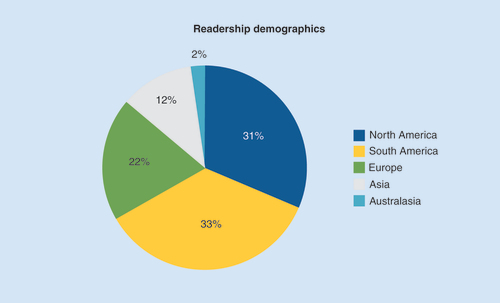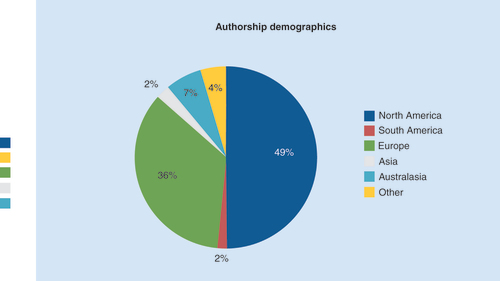To all our readers, we would like to welcome you to Volume 8 of Pain Management. We are pleased to introduce the first issue of 2018. In 2017, another exciting year for the journal, Pain Management continued the publication of timely, high quality articles on the topics of acute and chronic pain management. In this foreword, I am delighted to present some journal highlights from the past year.
Content highlights of 2017
At the time of writing (November 2017), our most highly read article of the last year was a Special Report entitled, ‘Latin–American guidelines for opioid use in chronic nononcologic pain’ [Citation1]. The paper was produced through the collaboration of 18 authors from a range of institutes across South America and focused on changes to guidelines for opioid use in Latin America. The article discusses the outcomes of a meeting between a panel of experts, The Change Pain Latin America (CPLA), which gathered in Guatemala City (Republic of Guatemala) in 2015 to discuss and develop general recommendations for the use of opioids in chronic non-oncologic pain based on the best available evidence. The article aims to update the understanding and knowledge of Latin–American physicians and to develop a clinical tool for use at every level of medical care.
Another of our most popular articles was an Editorial entitled, ‘Transcutaneous electrical nerve stimulation: current status of evidence’ from the first issue of 2017 [Citation2]. This piece was authored by Mark I Johnson, a member of the Pain Management Editorial Board, and his colleague Gareth Jones (both Center for Pain Research, Leeds Beckett University, UK). Transcutaneous electrical nerve stimulation (TENS) is a pain relief technique that involves delivering mild pulsed electrical currents across the surface of the skin in an attempt to stimulate low threshold nerves. Johnson and Jones discuss the current research in the field for TENS and evaluate recommendations for its use.
The most popular Research Article published in Pain Management in 2017 was a Short Communication entitled, ‘An over-the-counter central sensitization therapy: a chronic back pain registry study of pain relief, medication use and their adverse effects’. This collaborative effort came from researchers at Duke University (NC, USA), BioElectronics Corporation (MD, USA) and Binghamton University (NY, USA). The aim of this research was to determine the effectiveness of the ActiPatch medical devices in reducing chronic back pain over a 7-day trial. The authors concluded that it is an effective intervention for the majority of subjects for treating chronic back pain, without the known side-effects associated with medications. They do however note that further investigation through randomized clinical trials is required [Citation3].
I also wish to highlight the successful two-part interview series with Stefan Friedrichsdorf, Medical Director of the Department of Pain Medicine, Palliative Care and Integrative Medicine at Children’s Hospitals and Clinics of Minnesota (MN, USA) which specializes in treating babies, children and adolescents. In ‘Four steps to eliminate or reduce pain in children caused by needles (part 1)’ he discusses the four ‘non-negotiables’ for reducing needle pain for children [Citation4]. This is part of the ‘Children’s Comfort Promise’, which Children’s Minnesota was the first hospital worldwide to implement. In the second interview, entitled ‘Multimodal pediatric pain management (part 2)’ [Citation5], Friedrichsdorf discusses the use of multimodal (opioid-sparing) analgesia for hospitalized children in pain and how analgesics and adjuvant medications, interventions, rehabilitation, psychological and integrative therapies act synergistically for more effective pediatric pain control with fewer side effects than a single analgesic or modality.
Special mention goes to the following articles, which achieved the highest Altmetric scores in Pain Management throughout 2017, as we continue our successful partnership with the platform:
Our highest scoring paper on Altmetric was the Research Article, ‘A comparison of transdermal over-the-counter lidocaine 3.6% menthol 1.25%, Rx lidocaine 5% and placebo for back pain and arthritis’ [Citation6].
A Commentary article by another member of our Editorial Board, Michael A Erdek, and his colleague Peter J Pronovost (both Johns Hopkins University School of Medicine, MD, USA) was ranked second. This commentary discusses the need for an ethics framework for the use of opioids in treating chronic nonmalignant pain [Citation7].
In third position was a systematic review of randomized control trials of cancer pain management and evidence-based practices across Africa, Europe and North America [Citation8].
Readership demographics
It is encouraging to see that our journal’s popularity has continued worldwide through 2017.The highest percentage of readers in 2017 originated from the continents of South America (33%) and North America (31%; ). The single countries with the largest contributions to Pain Management’s readership are the United States (27%), Colombia (5.6%) and the UK (6.4%). We look forward to continuing the circulation of our journal content to an increasingly global audience in the upcoming year.
Authorship demographics
It is always interesting to consider the sources of our content and, looking back at 2017, the highest proportion of our content originated from the United States (42%) alongside a high percentage of content from European authors (36%; ). The highest individual country to write for Pain Management was the United States (42%) and the highest contributor country within Europe was the United Kingdom (17.8%). Pain Management continues to welcome content from across the globe, and we encourage unsolicited article proposals.
Spreading the word
Pain Management continues to be active across social media including on our Twitter, @fsgpmt [Citation9], and being associated with the LinkedIn Group for the Future Science Group website NeuroCentral [Citation10]. Our regular posts include journal highlights such as newly published content and the latest news in the world of acute and chronic pain management. This year, we have thoroughly enjoyed engaging with pain management professionals across the field and continue to grow our network presence. We welcome our readers to connect with us via social media as we continue into 2018.
Conclusion
We welcome all feedback from the community regarding direction of the field of pain management and any suggestions for topics you wish to see covered in Pain Management. As mentioned, we accept unsolicited research, as well as review and opinion article proposals. We would be delighted to hear from you if you have an interest in submitting.
We would also like to take this opportunity to thank all of our readers, contributing authors, valued Editorial Board members and peer reviewers for their continued support and collaboration as we continue to publish the latest cutting-edge research. As we move into 2018, we very much look forward to seeing the journals continued progression and development.
Financial & competing interests disclosure
Rhiannon Finnie is an employee of Future Science Ltd, publisher of Pain Management. The author has no other relevant affiliations or financial involvement with any organization or entity with a financial interest in or financial conflict with the subject matter or materials discussed in the manuscript apart from those disclosed.
No writing assistance was utilized in the production of this manuscript.
References
- Lara-Solares A , ZamoraCA , GarciaCAet al. Latin–American guidelines for opioid use in chronic nononcologic pain . Pain Manag.7 ( 3 ), 207 – 215 ( 2017 ).
- Johnson MI , JonesG . Transcutaneous electrical nerve stimulation: current status of evidence . Pain Manag.7 ( 1 ), 1 – 4 ( 2017 ).
- Staelin R , KoneruSN , RaweIM . An over-the-counter central sensitization therapy: a chronic back pain registry study of pain relief, medication use and their adverse effects . Pain Manag.7 ( 2 ), 99 – 111 ( 2017 ).
- Friedrichsdorf SJ . Four steps to eliminate or reduce pain in children caused by needles (part 1) . Pain Manag.7 ( 2 ), 89 – 94 ( 2017 ).
- Friedrichsdorf SJ . Multimodal pediatric pain management (part 2) . Pain Manag.7 ( 3 ), 161 – 166 ( 2017 ).
- Castro E , DentD . A comparison of transdermal over-the-counter lidocaine 3.6% menthol 1.25%, Rx lidocaine 5% and placebo for back pain and arthritis . Pain Manag.7 ( 6 ), 489 – 498 ( 2017 ).
- Erdek MA , PronovostPJ . The need for an ethics framework for the use of opioids in the treatment of chronic nonmalignant pain . Pain Manag.7 ( 4 ), 229 – 231 ( 2017 ).
- Odonkor CA , KimG , ErdekM . Global cancer pain management: a systematic review comparing trials in Africa, Europe and North America . Pain Manag.7 ( 4 ), 299 – 310 ( 2017 ).
- Pain Management Journal . Twitter . https://twitter.com/fsgpmt .
- Future Science Group Neurology . LinkedIn . https://www.linkedin.com/groups/8204606/profile .


